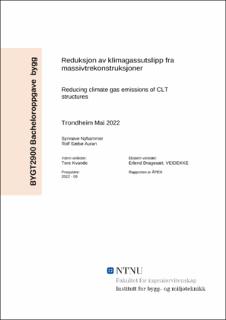| dc.contributor.advisor | Kvande, Tore | |
| dc.contributor.advisor | Dragesæt, Erlend | |
| dc.contributor.author | Nyhammer, Synnøve | |
| dc.contributor.author | Auran, Rolf Sæbø | |
| dc.date.accessioned | 2022-07-01T17:20:05Z | |
| dc.date.available | 2022-07-01T17:20:05Z | |
| dc.date.issued | 2022 | |
| dc.identifier | no.ntnu:inspera:106805903:113577157 | |
| dc.identifier.uri | https://hdl.handle.net/11250/3002154 | |
| dc.description.abstract | Bruk av bærekonstruksjon i tre er å foretrekke før stål og betong med tanke på å redusere klimafotavtrykket til bygninger. Bygninger der krysslaminerte treelementer (massivtre) utgjør komponenter som vegger, tak og etasjeskillere, har derfor blitt en stadig mer anvendt byggemetode de siste årene. Men hvor gunstig er egentlig dagens trekonstruksjonsløsninger med tanke på lavt klimagassutslipp?
Denne bacheloroppgaven undersøker hvordan ulike byggtekniske detaljer tilhørende et referansebygg med bærekonstruksjon i massivtre kan forbedres med formål å ta ned klimagassutslippene. Det er tatt utgangspunkt i byggtekniske løsninger med innsalg av stål og betong. Bakgrunnen for dette valget er at gruppen opplever det som interessant at en bærekonstruksjon hvor stål og betong velges bort til fordel for massivtre, likevel inneholder større innslag av disse materialene. Betong brukes som avrettingsmasse i etasjeskiller for å øke dekkets tyngde, og på den måte bedre de akustiske forholdene i bygget. Stål brukes hovedsakelig til sammenføyninger eller bærende bjelker.
Oppgaven omfatter en livsløpsanalyse av dekkeløsning og ståldetaljer brukt i Maskinparken TRE. Livsløpsanalysen er gjort ved bruk av One Click LCA for en systematisk vurdering av anvendte bygningsmaterialer i prosjektet. One Click estimerer utslipp uttrykt gjennom påvirkningskategorien GWP (CO2e[kg]) fra ulike bygningskomponenter, samtidig som det redegjøres for hvor stor prosentandel av utslippene som kan knyttes til enkeltmaterialene i oppbygningen av løsningene. Resultatet gir en pekepinn på hvilke materialer som bør erstattes for å få ned klimagassutslippene.
Gjennom studien kommer det frem at det er et tydelig potensial for en utslippsreduksjon fra Maskinparken TRE. Av resultatene fremgår det at en løsning hvor avretningsmasse erstattes med pukk, samt et himlingssystem med redusert stålforbruk, ga størst reduksjon av klimagasser gjennom et utslippskutt på 91029 kg CO2e. Å erstatte stålkomponenter med løsninger i treverk ga en total besparelse på 1808 kg CO2e. Disse tiltakene vil til sammen utgjøre en klimagassreduksjon for Maskinparken TRE tilsvarende 11.6% av byggets totale utslipp knyttet til materialforbruk. | |
| dc.description.abstract | The use of timber structures is preferable to steel and concrete, in the perspective of reducing the climate footprint of buildings. Buildings where cross-laminated timber (CLT) constitute components such as walls, roofs and floor slabs, have therefore become more common in the past few years. But how optimal are today's CLT structural solutions in terms of reducing climate gas emissions?
The aim of this thesis is to examine various building solutions for a cross-laminated timber (CLT) structure. Different structural details featuring elements of steel and concrete are discussed and studied. The subject was chosen because the group found it interesting that a structural solution that foregoes steel and concrete in favour of CLT, will still normally contain large amounts of these materials. A concrete screed is used in floor slabs to increase their mass and stiffness to improve the acoustic performance of the structure. Steel mostly appears in the connection points of composite elements.
The study involves a Life Cycle Assessment (LCA) of a slab solution and steel details for a new CLT building in Trondheim, “Maskinparken TRE”. The software One Click will be used as a calculation tool for the LCA. LCA is a systematic, standardized method to quantify the environmental impacts (Hill, 2013) of materials used for building solutions. One Click estimates the global warming potential (GWP) of the solutions in total, and separately by materials, expressed as an equivalent emissions of CO2 (CO2e, [kg]) This information can be used to determine whether some of the materials in the components should be replaced to minimize their environmental impact.
The study aims to present building components with lower environmental impact, but similar quality to the original. Thus, the focus should primarily be on the potential reduction of climate gas emissions. A great reduction of GWP can be achieved if the process of choosing materials for the building components includes their environmental impact in decision making. A new proposed composite slab resulted in a 91029 kg CO2e reduction for the total climate gas emissions from Maskinparken TRE. Alternative solutions for the steel composite connections with sustainable advantages had a total reduction of 1808 kg CO2e. The building solutions proposed in the study achieved a total reduction of CO2e of 11.6%. | |
| dc.language | nob | |
| dc.publisher | NTNU | |
| dc.title | Reduksjon av klimagassutslipp fra massivtrekonstruksjoner | |
| dc.type | Bachelor thesis | |
